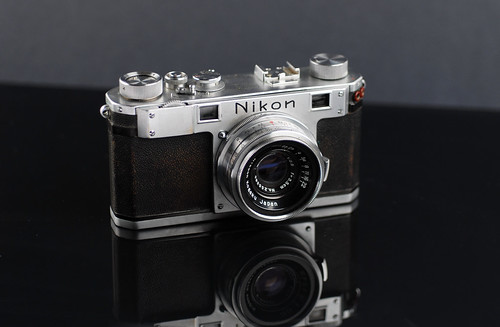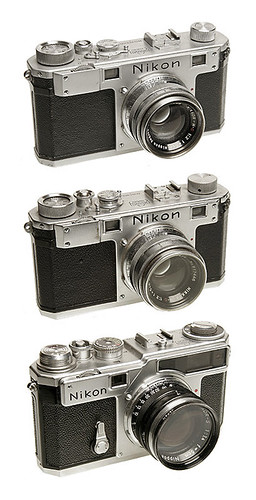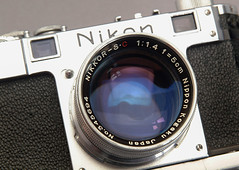Nikon rangefinder cameras

|
| Nikon M image by Cheol Jang (Image rights) |
The Nikon was the first camera introduced by the optical manufacturer Nippon Kōgaku K.K.. It is a 35mm rangefinder camera, now known as the Nikon I.[1] The original design was approved by September 1946. After over a year of development and testing, manufacture began in March 1948. Sales began in September 1948 with a shipment of 100 cameras to Hong Kong. Production grew slowly over the next year, with all but a few of the cameras being sold to overseas markets including the United States. Because it uses a derivative of the Zeiss Contax camera mount, the Nikon camera bears a strong external resemblance to that camera. However, both the shutter and rangefinder mechanism followed the Leica's, resulting in a simpler, easier to manufacture design.
The factory, encouraged by the Japanese government, chose the 24 × 32mm frame size pioneered by Chiyoda Kogaku—known as the Nippon format—which yielded more frames per length of film, and matched more closely the common paper sizes. However, the United States importers, Overseas Finance and Trading Company, objected to this non-standard format. It did not correspond to the automatic slide cutting machines being used in the US, and the images might be sliced in the middle. In addition, the Central Purchasing Office (CPO) that controlled the sales of cameras to the military exchange stores in Japan decided that they would not approve cameras for sale with that format either. Effectively cut off from the two most important markets for their new camera, Nippon Kogaku redesigned the camera's film gate, pressure plate and gearing in August 1949. This became the Nikon M. Introduced in the autumn of 1949, this model can be recognized by the M preceding the body number. The Nikon's body casting and shutter did not permit increasing the format to a full 24 x 36mm. Therefore Nippon Kogaku settled for an intermediate frame format of 24 × 34mm, but did change the gearing to increase the number of perforations per image to the standard 8 (instead of 7 for the 24 x 32), This was acceptable to the export market as slides, although still slightly narrower, were now always cut between frames.
The Nikon M was sold in the PX stores, and United States sales resumed, but the camera received little attention in the western media until the fall of 1950, when photographers from the Life magazine began reporting on the Nikkor lenses' sharpness. The Nikkor-P.C 1:2 f=8.5cm received the first attention, but the 5cm f1.5 (later f1.4) and 135mm Nikkors also received praise. A demand to fit Nikkors to reporters' Leicas were immediately met at the factory in Tokyo, and soon the word spread that these Japanese lenses were just as good as, or possibly better than their German counterparts.
In November 1950, Nippon Kogaku made built-in flash synchronization a factory standard.

|
| Nikon M, S, and SP image by Rick Soloway (Image rights) |
The Nikon S is a Nikon M with these flash sync contacts, two double sockets set in the upper left-hand edge of the body. The M was dropped from the serial numbers in April 1951: that is, some cameras were made with synchronisation, but with a serial number prefixed 'M', but all cameras sold with synchronisation are considered a Nikon S by the factory, even if they have the 'M' prefix (auctioneer's notes at Leitz Auction call this a Nikon MS.[2] A small number of cameras were made in black-painted finish.[3]
The Nikon I, M and S are all similar in appearance. They are heavy, have shutter speeds only up to 1/500th of second and the viewfinder for the 50mm lens is small. Despite these shortcomings, the Nikon S sold well with over 34,000 manufactured from 1951 through 1954. By chance, a number of Nikon S cameras have one more serial number digit, known as the 8-digit Nikon S. When reaching 6099999 the engraver continued at 60910000, but it was soon realized that the long serial number was impractical, and after some 1200 cameras, the numbering reverted to 6100000. The 609 prefix refers to the date the design was approved in September 1946. The 8-digit camera is about twice as valuable as the ordinary 7-digit version, while Nikons MIOJ (Made in Occupied Japan) are even more valuable.
The Nikon S2 (1954) finally has a standard 24x36mm frame. Its shutter has a top speed of 1/1000 second, and it has lever film-advance. It can be used with an accessory motor winder. It has a slightly larger viewfinder than its predecessors, and this makes a short stepped section on the top plate. The S2 (and subsequent models) was available with chrome-plated or black-painted metalwork. McKeown states that 56,000 of the camera were made, more than any other of these cameras.[4]
The Nikon SP (1957) has an improved viewfinder, adjustable for several focal lengths, and the stepped section of the top plate over it is longer; half the width of the camera. The window incorporating the main viewfinder window extends above the lens somewhat, with a curved profile. The name 'NIKON' appears on the top-right corner of the body, not in the centre. The whole camera back is removable to exchange for an improved motor drive. A small battery-powered lamp accessory was made, mounted in the shoe, to illuminate the VF frame-lines.[5]
The Nikon S3 (1958; introduced alongside the SP, not replacing it) has a rectangular viewfinder again; larger than that of the S2. Without the curved extension to the VF window, 'NIKON' appears above the lens again. The stepped top plate above it is still long, like that of the SP.
The Nikon S4 is a simplified version of the S3; it does not have a self-timer. It was only made in chrome finish.
One half-frame (18x24mm) model exists, the Nikon S3M from 1960. Only 195 cameras of the model were made.[6][7] It is a half-frame S3, with a full set of features, and may be seen in chrome or black finish.
Nikon's first SLR camera, the 1959 Nikon F, shares the basic body configuration of the contemporary rangefinder models. All Nikon rangefinders are considered highly collectible and fetch very high sale prices, commanding just as high prices as those for Leica cameras of the same period.
- See also the page about lenses in Nikon rangefinder mount.

|
| (Image rights) |
Notes
- ↑ Nikon I serial no.609718, with Nikkor-H.C 1:2 f=5cm no.70879, sold at the 42nd Leitz Photographica Auction, in June 2023.
- ↑ Nikon 'M' with synchronisation (the camera is listed as a Nikon MS); serial no.M6093240, with Nikkor_S.C 1:1.4 f=5cm no.317648, sold at the 42nd Leitz Auction.
- ↑ Nikon S in black finish, serial no.6108685, with Nikkor-S.C 1:1.4 f=5cm no.331242, sold at the 43rd Leitz Auction, in November 2023. The auctioneer's notes recount the 'legend' that black-painted Nikons began when Life Magazine requested twenty of them.
- ↑ McKeown, James M. and Joan C. McKeown's Price Guide to Antique and Classic Cameras, 12th Edition, 2005-2006. USA, Centennial Photo Service, 2004. ISBN 0-931838-40-1 (hardcover). ISBN 0-931838-41-X (softcover). p.723-5
- ↑ Frame illuminator sold at the 37th Leitz Photographica Auction, in November 2020.
- ↑ Nikon S3M half-frame rangefinder, serial no.6600156 (that is no.156 of the type), offered for sale with a Nikkor-S.C 1:1.4 f=5cm (surely not the original lens supplied with a half-frame camera), and with an electric motor winder and battery packs, and a pistol grip, at the 43rd Leitz Auction.
- ↑ Nikon S3M serial no.6600172, sold at the 44th Leitz Auction, in June 2024. Just the camera body with a soft-relese button; many pictures, including the film chamber.
Links
In English:
- Official Nikon's History & Technology site:
- Nikon Rangefinder Lens Price & Information Guide
- Short history of Nikon until 1949 (pdf) at the Nikon Historical Society website, with details about the Nikon I
- Nikon S2 at Photoethnography by Karen Nakamura
- Nikon S3 at Scott's Photographica Collection
- Nikon S2 at the Vintage Nikon DSLR website
- Nikon MS rangefinder instruction manual at www.orphancamers.com
- Nikon SP Rangefinder instruction manual at www.orphancameras.com
- Marine Housing, one of only three made by Nikon for the S cameras, sold at the nineteenth Westlicht Auction, in May 2011.
- Articles at Cameraquest:
- Nikon I
- Nikon One Garage Sale Treasure
- Nikon M Unsynced
- Nikon M recovered from the trash
- Nikon M Synced
- Nikon S
- Nikon S2 nice shooter
- Nikon S2 Black Dial Prototype?
- Nikon S2 Black 1st Pro Nikon
- Nikon S3 Black Olympic
- Nikon S3M Black Half-frame w/ Motor Nikon's rarest regular production camera
- Nikon S3 2000
- Nikon S4
- Nikon SP Rangefinder System Overview
- Nikon SP Black most handsome Nikon?
- Nikon SP Motor Jacobson Powercon Cordless Battery Pack
- Nikon SP Variations
- Nikon SP Illuminator a unique accessory Leica should copy
- Nikon SP 2005
- Nikon S, Nikon S2 on www.collection-appareils.fr by Sylvain Halgand (in French)
In Japanese:
- Nikon kamera no koneta, with many documents on the Nikon rangefinder models